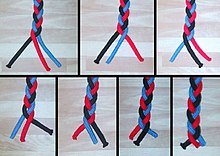French braid
This article's lead section may be too short to adequately summarize the key points. (November 2010) |


A French braid, or French plait, is a type of braided hairstyle.
Description
In the simplest form of three-strand braid, all the hair is initially divided into three sections, which are then simultaneously gathered together near the scalp. In contrast, a French braid starts with three small sections of hair near the crown of the head, which are then braided together toward the nape of the neck, gradually adding more hair to each section as it crosses in from the side into the center of the braid structure. The final result incorporates all of the hair into a smoothly woven pattern over the scalp. If the main mass of hair is initially parted into two or more sections along the scalp that are kept separate from one another, multiple French braids may be created, each in its own section.
Compared to the simplest form of hair braid, a French braid has several practical advantages: it can restrain hair from the top of the head that is too short to reach the nape of the neck, and it spreads the weight and tension of the braid across a larger portion of the scalp. Its sleeker appearance is also sometimes viewed as more elegant and sophisticated. However, a French braid is more difficult to construct than a simple braid because of its greater complexity; when performed on one's own hair, it also requires a more prolonged elevation of the hands above the back of the head, and leaves more tangled hair along the scalp when unbraiding.
In this style of braid start on top of the head and braid it till the end of the hair. Braiding in this manner can be done with different braid types but the most popular are the classic type and the fishtail type.[1]
History
The hairstyle originated in France. In French, the hairstyle is natively called tresse française.[2]
The phrase "French braid" appears in an 1871 issue of Arthur's Home Magazine, used in a piece of short fiction that describes it as a new hairstyle ("...do up your hair in that new French braid...").[3] However, no visual illustrations are provided for that context, making it impossible to tell whether it refers to the same hairstyle described above.
Variations
Variations on this hairstyle include:
- Dutch braid: A Dutch braid (also called an inverted French braid or pineapple braid) is created when the three hair sections are crossed under each other, instead of over. It results in the look of a braid standing up from the rest of the hair, instead of being under the hair.
- Fishtail braid: A fishtail braid resembles a French braid in its smoothly woven appearance, but divides the hair into only two sections instead of three. This style was called the "Grecian braid" in the 19th century.[4]
- Variations of this braid are also used to prepare horses' tails for showing, polo and polocrosse.[5]
- Variation of this braid is also known as a cornrow.
See also
References
- ^ "Braid Guide with Explanations of Braids/French Braid"
- ^ Comment faire une tresse française? (How to French plait)
- ^ March Westland (1871). "Our New Congressman". Arthur's Home Magazine. 37–38: 222–223.
- ^ "Chapter LX.-- The Hair. Part I-- Arrangement. 888. Fillets". Ward and Lock's Home Book: a Domestic Encyclopædia Forming a Companion Volume to "Mrs. Beeton's Book of Household Management": 538–539. 1882.
- ^ Braiding and Plaiting Your Horse Retrieved 2010-2-20
External links
- How to French-Braid – step-by-step instructions on the technique.
